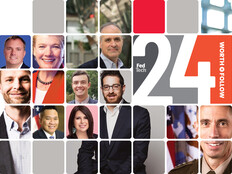DOD, FCC Officials Say Digital Transformation Requires Leadership, Security
The term “digital transformation” is somewhat nebulous, but a group of federal officials argued last week that, although it might involve different innovations, bringing digital technology into agencies requires strong IT leadership with a clear vision.
Speaking at the Digital Transformation in Government event on Feb. 18, produced by FedInsider, the officials said that mobility and the cloud were key aspects of the shift in their organizations. They also noted that security remains a paramount concern, and the implementation of appropriate security and access controls and technologies is something agencies will continue to grapple with as they evolve.
A Clear Strategy to Get Resources
Frank Konieczny, chief technology officer for the Office of Information Dominance and CIO for the Office of the Secretary for the U.S. Air Force, said that digital transformation for the Air Force means migrating more services to the cloud and “energizing” mobility across the service branch. But he said that hasn’t been done across the board, mainly because of problems related to the Air Force’s procurement schedules. Konieczny said the Air Force’s office in Silicon Valley is investigating how new commercial technologies can be used in the Air Force’s existing technology platforms.
“How do we inject transformational technologies in without going through a long procurement cycle?” Konieczny asked. He added that the Air Force is trying to determine whether it can “plug things into a particular weapons system” to see how they might work.
Andrew Jacobs, strategy and planning branch chief for the health IT innovation and advanced technology development division at the Defense Health Agency (DHA), said his agency, which was created in 2013, started out with a business transformation. The DHA created different directorates as part of its organization structure, Jacobs said. However, in terms of digital transformation, Jacobs said the DHA is squarely focused on data.
The DHA provides medical services across the different branches of the U.S. armed forces and, as a result, it has a great deal of data, including personal health data and data collected from wearable devices. The DHA has been focused on “bringing in all of that data, normalizing it and making it actionable for the people that need it,” Jacobs said.
Since the DHA runs so many facilities around the globe, it needs to look at how its IT will transform 10 years from now, not just in one to two years, Jacobs said, adding that the DHA needs to take care of equipment and facilities, which include everything from beds to video conferencing gear and services.
Mark Krzysko, deputy director for enterprise information in the Office of the Under Secretary of Defense for Acquisition, Technology and Logistics, said digital transformation ultimately comes down to having the right leadership. IT leaders need to know that certain components of agencies, especially large ones like the Defense Department, will change at their own pace. He noted that 20 percent of employees might not want to change, so leaders need to go after the other 80 percent. “If you tell people where they’re going and why, they might go,” he said.
How does digital transformation get expressed or show its value? Sometimes, it’s very clear. John Skudlarek, deputy CIO for the Federal Communications Commission, noted that the FCC unveiled a new Consumer Help Center in January 2015. The customer complaints center takes advantage of Zendesk’s software, and instead of using custom code that, according to Skudlarek, would have taken six months to deploy and cost $2.4 million, the FCC was able to deploy the system in three months for only $450,000.
Skudlarek said that digital technology is the “accelerant” but that transformations ultimately are connected to specific agencies’ missions and needs. “We can actually get stuff done faster and cheaper, and just as good and perhaps better, using these new technologies,” he said.
However, Krzysko said that “[return on investment] is a very difficult measure to get to.” In certain federal IT environments, certain agency components are the sole providers of technology solutions, making it difficult to provide a clear ROI.
“You have to measure the entire complexity of what it brings, not just the financial return,” Krzysko said. IT managers should always ask whether a new digital technology is “not just cheaper” but also “more efficient and effective.”
The Importance of Security
“At the end of the day you don’t forget about security,” Skudlarek said. He added that the FCC feels it can get better security, especially for cloud services, by using managed services with accredited cloud providers. IT managers need to look at security requirements for their data and determine how sensitive it is and which controls need to placed on the data.
Skudlarek added that if the FCC had its own on-premises data center, the agency could secure its servers without a lot of coordination. However, because the FCC is a relatively small agency, it looks to accredited cloud providers to offer security protections. He added that “coordination mechanisms may become more complex as the direct control diminishes.”
For the past two years, Konieczny said, the Air Force has been conducting a “neutral access” pilot program for the DOD’s Joint Information Environment, a unified IT environment that combines the DOD’s many different networks.
However, Konieczny said that “access policies have been very absent” from the pilot. It’s very difficult for the functional community to understand how difficult it is to access documentation or the systems themselves.”
Jacobs said the DHA always keeps security in mind, because health data is very valuable on the black market. He compared security protocols to a hammer, suggesting that security can offer protection, but if it fails, there could be dire consequences. A hammer, he said, “can be used to build a house or destroy a house,” adding that “you need to look at both sides.”









